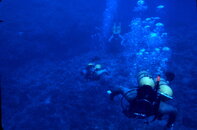Neutral Buoyancy Summation
The goal of these combined systems is to obtain neutral buoyancy which maximizes the diver’s trim. Trim is the diver's attitude in the water, in terms of balance with the direction of motion. Accurately controlled trim decreases swimming effort, as it reduces the sectional area of the diver as they pass through the water. A slight head down trim is the best position to reduce down thrust during finning, and this reduces silting and fin impact with the bottom. It also allows the diver to look down comfortably. A stable horizontal trim requires that the diver's center of gravity to be directly below the center of buoyancy (the centroid).
On the surface with a full tank of air, a diver can adjust their lead so that when their BCD is fully deflated and they have a half breath of air, they float at eye level in the water. This is the standard for initial assessment of neutral buoyancy. As they make their descent, their neoprene, and the residual air in their BCD is further compressed. They may then need to add air via filling their lungs or adding air to their BCD to once again achieve neutral buoyancy at depth. On ascent, the release of BCD air and a long slow exhalation is needed as the air expands (according to Boyle’s law) to control buoyancy, lung inflation, and rate of ascent.
Other advantages of neutral buoyancy maintenance include reduced energy expenditure, reduced decompression stress, better gas management, and a sense of freedom and weightlessness without free fall. The diver can hover upside down and peer into crevices and holes without fear of striking the bottom. They can lie on their back in the water column without sinking to spy surface marine creatures and boats. Most importantly they can relax, and focus on work or simple enjoyment while minimizing environmental impact.
[1]






